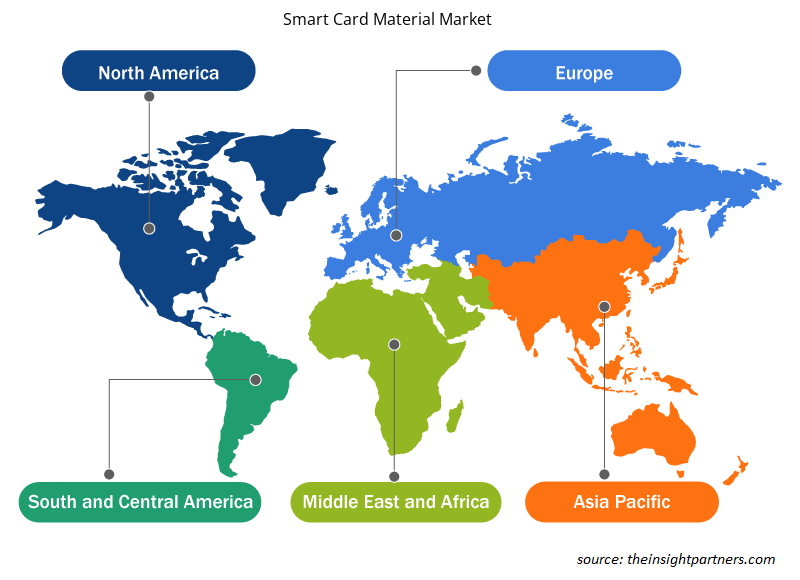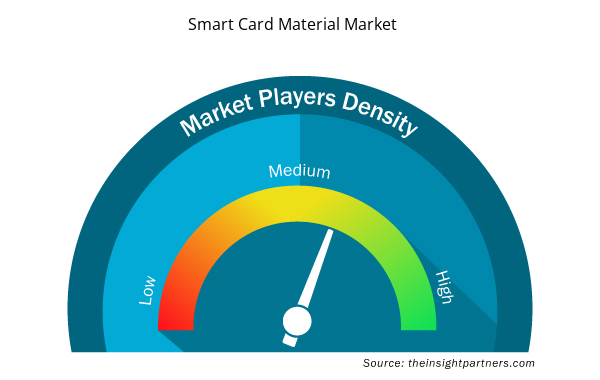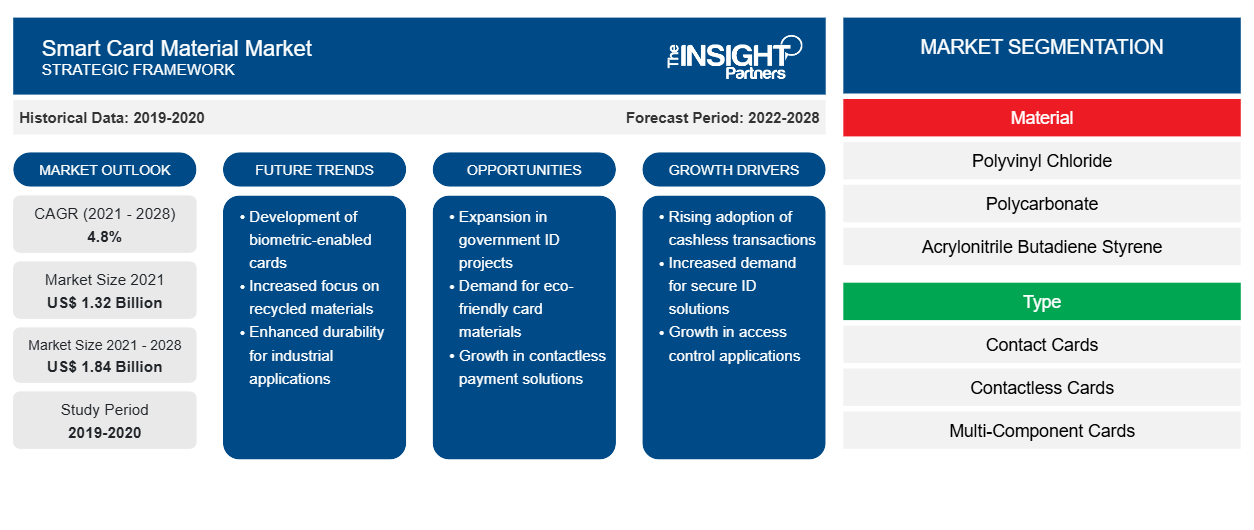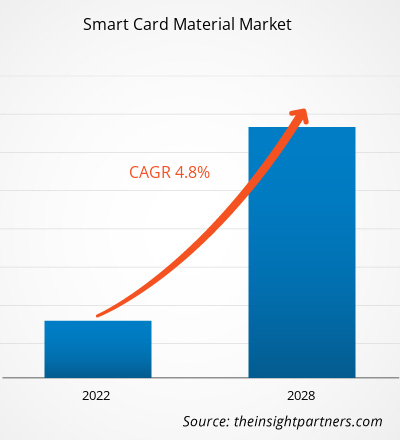Si prevede che il mercato dei materiali per smart card raggiungerà 1.837,78 milioni di dollari entro il 2028, rispetto ai 1.324,57 milioni di dollari del 2021; si prevede una crescita a un CAGR del 4,8% dal 2021 al 2028.
Una smart card, un tipo di chip card, è una carta di plastica che contiene un chip di computer incorporato, sia di tipo memoria che microprocessore, che memorizza e gestisce dati. Questi dati sono solitamente associati a un valore o a un'informazione, o a entrambi, che vengono memorizzati ed elaborati all'interno del chip. I materiali delle smart card si riferiscono a materiali chimici utilizzati nella fabbricazione di queste carte. Questi materiali supportano l'incorporamento e la stampa di informazioni su di essi.
Nel 2020, l'Asia Pacifica deteneva la quota maggiore del mercato globale dei materiali per smart card . La domanda di materiali per smart card in questa regione è in aumento a causa del crescente utilizzo delle smart card nel settore delle telecomunicazioni. Inoltre, la crescente tendenza alla globalizzazione e la proliferazione del settore bancario, dei servizi finanziari e delle assicurazioni (BFSI) sono fattori chiave che favoriscono la crescita del mercato dei materiali per smart card nella regione.
Personalizza questo report in base alle tue esigenze
Riceverai la personalizzazione gratuita di qualsiasi report, comprese parti di questo report, o analisi a livello nazionale, pacchetto dati Excel, oltre a usufruire di grandi offerte e sconti per start-up e università
- Scopri le principali tendenze di mercato in questo rapporto.Questo campione GRATUITO includerà analisi di dati che spaziano dalle tendenze di mercato alle stime e alle previsioni.
Impatto della pandemia di COVID-19 sul mercato dei materiali per smart card
L'attuale pandemia di COVID-19 ha alterato drasticamente lo stato del settore chimico e dei materiali e ha avuto un impatto sulla crescita del mercato dei materiali per smart card. Il calo significativo delle performance di diversi settori industriali ha avuto un impatto sulla domanda di materiali per smart card. L'impatto della pandemia varia nei diversi segmenti applicativi. Un'impennata nel traffico dati e nei servizi vocali ha giovato a molti operatori delle telecomunicazioni, tra cui gli operatori di data center mobili e a banda larga. Tuttavia, le misure di blocco imposte dai governi hanno disturbato le catene di fornitura di materie prime come PVS, ABS e PETG necessarie per la produzione di smart card. La diffusione della malattia ha avuto un impatto negativo sulle operazioni nei settori governativo e BFSI. Tuttavia, poiché le economie stanno pianificando di rilanciare le loro operazioni, si prevede che la domanda di materiali per smart card aumenterà a livello globale nei prossimi anni.
Approfondimenti di mercato
Crescita significativa nei settori delle telecomunicazioni e dell'assistenza sanitaria
Le smart card sono ampiamente utilizzate nel settore delle telecomunicazioni. L'uso più importante delle smart card in questo settore è sotto forma di schede SIM (Subscriber Identity Module) o schede a circuito integrato universale (UICC). Queste smart card sono prodotte principalmente da materiali in polivinilcloruro (PVC) e acrilonitrile butadiene stirene (ABS). La tecnologia delle smart card utilizzata nelle applicazioni in questo settore ha subito continui progressi negli ultimi anni, il che ha aumentato il consumo di queste card. Inoltre, le organizzazioni sanitarie in tutto il mondo stanno implementando smart health card con un'ampia gamma di funzionalità e applicazioni.
Approfondimenti regionali sul mercato dei materiali per smart card
Le tendenze regionali e i fattori che influenzano il mercato dei materiali per smart card durante il periodo di previsione sono stati ampiamente spiegati dagli analisti di Insight Partners. Questa sezione discute anche i segmenti e la geografia del mercato dei materiali per smart card in Nord America, Europa, Asia Pacifico, Medio Oriente e Africa e America centrale e meridionale.

- Ottieni i dati specifici regionali per il mercato dei materiali per smart card
Ambito del rapporto sul mercato dei materiali per smart card
| Attributo del report | Dettagli |
|---|---|
| Dimensioni del mercato nel 2021 | 1,32 miliardi di dollari USA |
| Dimensioni del mercato entro il 2028 | 1,84 miliardi di dollari USA |
| CAGR globale (2021 - 2028) | 4,8% |
| Dati storici | 2019-2020 |
| Periodo di previsione | 2022-2028 |
| Segmenti coperti | Per materiale
|
| Regioni e Paesi coperti | America del Nord
|
| Leader di mercato e profili aziendali chiave |
|
Densità dei player del mercato dei materiali per smart card: comprendere il suo impatto sulle dinamiche aziendali
Il mercato dei materiali per smart card sta crescendo rapidamente, spinto dalla crescente domanda degli utenti finali dovuta a fattori quali l'evoluzione delle preferenze dei consumatori, i progressi tecnologici e una maggiore consapevolezza dei vantaggi del prodotto. Con l'aumento della domanda, le aziende stanno ampliando le loro offerte, innovando per soddisfare le esigenze dei consumatori e capitalizzando sulle tendenze emergenti, il che alimenta ulteriormente la crescita del mercato.
La densità degli operatori di mercato si riferisce alla distribuzione di aziende o società che operano in un particolare mercato o settore. Indica quanti concorrenti (operatori di mercato) sono presenti in un dato spazio di mercato in relazione alle sue dimensioni o al valore di mercato totale.
Le principali aziende che operano nel mercato dei materiali per smart card sono:
- Società chimica Eastman
- Società PetroChina Limited
- Società Solvay SA
- KEM UNO
- SABICO
Disclaimer : le aziende elencate sopra non sono classificate secondo un ordine particolare.

- Ottieni una panoramica dei principali attori del mercato dei materiali per smart card
Approfondimenti sulle applicazioni
In base all'applicazione, il mercato dei materiali per smart card è segmentato in BFSI, governo, telecomunicazioni, vendita al dettaglio, sanità, ospitalità e altri. Il segmento delle telecomunicazioni ha detenuto la quota maggiore del mercato dei materiali per smart card nel 2020. Le smart card sono utilizzate come schede telefoniche prepagate (schede di memoria a valore memorizzato) e schede SIM basate su smart card a microprocessore o UICC nei telefoni cellulari. I prodotti smart card più venduti in questo settore sono SIM e UICC, in termini di volume e valore.
Tra i protagonisti del mercato globale dei materiali per smart card figurano Eastman Chemical Company, PetroChina Company Limited, Solvay SA, KEM ONE, SABIC, 3A Composites GmbH, Teijin Limited, LG Chem, BASF SE e Westlake Chemical Corporation.
Segnala i riflettori
- Tendenze industriali progressive nel mercato dei materiali per smart card per aiutare gli operatori a sviluppare strategie efficaci a lungo termine
- Strategie di crescita aziendale adottate dalle aziende che operano nei mercati sviluppati e in via di sviluppo
- Analisi quantitativa del mercato dei materiali per smart card dal 2019 al 2028
- Stima della domanda globale di materiali per smart card
- Analisi delle cinque forze di Porter per illustrare l'efficacia degli acquirenti e dei fornitori che operano nel settore
- Sviluppi recenti per comprendere lo scenario competitivo del mercato
- Tendenze e prospettive di mercato, nonché fattori che guidano e frenano la crescita del mercato dei materiali per smart card
- Assistenza nel processo decisionale evidenziando le strategie di mercato che sostengono l'interesse commerciale, portando alla crescita del mercato dei materiali per smart card
- La dimensione del mercato dei materiali per smart card in vari nodi
- Panoramica dettagliata e segmentazione del mercato, nonché dinamiche del settore dei materiali per smart card
- Dimensioni del mercato dei materiali per smart card in varie regioni con promettenti opportunità di crescita
Mercato dei materiali per smart card
Per materiale
- Cloruro di polivinile (PVC)
- Policarbonato (PC)
- Acrilonitrile Butadiene Stirene (ABS)
- Polietilene tereftalato-glicole (PETG)
- Altri
Per tipo
- Schede di contatto
- Carte contactless
- Schede multicomponente
Per applicazione
- BFSI
- Governo
- Telecomunicazione
- Vedere al dettaglio
- Assistenza sanitaria
- Ospitalità
- Altri
Profili aziendali
- Società chimica Eastman
- Società PetroChina Limited
- Società Solvay SA
- KEM UNO
- SABICO
- 3A Compositi GmbH
- Teijin limitata
- LG Chimica
- BASF SE
- Società chimica Westlake
- Analisi storica (2 anni), anno base, previsione (7 anni) con CAGR
- Analisi PEST e SWOT
- Valore/volume delle dimensioni del mercato - Globale, regionale, nazionale
- Industria e panorama competitivo
- Set di dati Excel



Report Coverage
Revenue forecast, Company Analysis, Industry landscape, Growth factors, and Trends

Segment Covered
This text is related
to segments covered.

Regional Scope
North America, Europe, Asia Pacific, Middle East & Africa, South & Central America

Country Scope
This text is related
to country scope.
Domande frequenti
The contactless cards segment is the fastest growing segment in the global smart card material market during the forecasted period. Contactless cards are the smart cards with contactless credentials and have a size like credit cards or debit cards. The market for the contactless cards segment is growing due to its various benefits.
The telecommunication segment held the largest share of the market in 2021. In the telecommunication industry, smart cards are used in two primary applications. Firstly, it is used as prepaid (stored value memory cards) telephone cards and as the microprocessor smart card-based subscriber identity module (SIM) or universal integrated circuit card (UICC) in mobile phones.
The contact cards segment held the largest share of the market in 2021. Contact cards are the smart cards that have a size like conventional debit and credit card. Contact smart card contains a single, embedded, and integrated circuit chip that consists of either memory or memory plus microprocessor.
The polyvinyl chloride segment held the largest share of the global smart card material market in 2021. Polyvinyl chloride is the most common and strong plastic material used for card manufacturing. The material is used for contact and contactless cards.
The major players operating in the global smart card material market are Eastman Chemical Company; PetroChina Company Limited; Solvay S.A.; KEM ONE; SABIC; 3A Composites GmbH; Teijin Limited; LG Chem; BASF SE; and Westlake Chemical Corporation; among others.
In 2021, Asia Pacific held the largest share of the global smart card material market. The major factor driving the smart card materials market in the Asia Pacific region is the increasing use of smart cards in various applications such as government, transportation, retail, and education sectors.
Trends and growth analysis reports related to Chemicals and Materials : READ MORE..
The List of Companies - Smart Card Materials Market
- Eastman Chemical Company
- PetroChina Company Limited
- Solvay S.A.
- KEM ONE
- SABIC
- 3A Composites GmbH
- Teijin Limited
- LG Chem
- BASF SE
- Westlake Chemical Corporation
The Insight Partners performs research in 4 major stages: Data Collection & Secondary Research, Primary Research, Data Analysis and Data Triangulation & Final Review.
- Data Collection and Secondary Research:
As a market research and consulting firm operating from a decade, we have published and advised several client across the globe. First step for any study will start with an assessment of currently available data and insights from existing reports. Further, historical and current market information is collected from Investor Presentations, Annual Reports, SEC Filings, etc., and other information related to company’s performance and market positioning are gathered from Paid Databases (Factiva, Hoovers, and Reuters) and various other publications available in public domain.
Several associations trade associates, technical forums, institutes, societies and organization are accessed to gain technical as well as market related insights through their publications such as research papers, blogs and press releases related to the studies are referred to get cues about the market. Further, white papers, journals, magazines, and other news articles published in last 3 years are scrutinized and analyzed to understand the current market trends.
- Primary Research:
The primarily interview analysis comprise of data obtained from industry participants interview and answers to survey questions gathered by in-house primary team.
For primary research, interviews are conducted with industry experts/CEOs/Marketing Managers/VPs/Subject Matter Experts from both demand and supply side to get a 360-degree view of the market. The primary team conducts several interviews based on the complexity of the markets to understand the various market trends and dynamics which makes research more credible and precise.
A typical research interview fulfils the following functions:
- Provides first-hand information on the market size, market trends, growth trends, competitive landscape, and outlook
- Validates and strengthens in-house secondary research findings
- Develops the analysis team’s expertise and market understanding
Primary research involves email interactions and telephone interviews for each market, category, segment, and sub-segment across geographies. The participants who typically take part in such a process include, but are not limited to:
- Industry participants: VPs, business development managers, market intelligence managers and national sales managers
- Outside experts: Valuation experts, research analysts and key opinion leaders specializing in the electronics and semiconductor industry.
Below is the breakup of our primary respondents by company, designation, and region:

Once we receive the confirmation from primary research sources or primary respondents, we finalize the base year market estimation and forecast the data as per the macroeconomic and microeconomic factors assessed during data collection.
- Data Analysis:
Once data is validated through both secondary as well as primary respondents, we finalize the market estimations by hypothesis formulation and factor analysis at regional and country level.
- Macro-Economic Factor Analysis:
We analyse macroeconomic indicators such the gross domestic product (GDP), increase in the demand for goods and services across industries, technological advancement, regional economic growth, governmental policies, the influence of COVID-19, PEST analysis, and other aspects. This analysis aids in setting benchmarks for various nations/regions and approximating market splits. Additionally, the general trend of the aforementioned components aid in determining the market's development possibilities.
- Country Level Data:
Various factors that are especially aligned to the country are taken into account to determine the market size for a certain area and country, including the presence of vendors, such as headquarters and offices, the country's GDP, demand patterns, and industry growth. To comprehend the market dynamics for the nation, a number of growth variables, inhibitors, application areas, and current market trends are researched. The aforementioned elements aid in determining the country's overall market's growth potential.
- Company Profile:
The “Table of Contents” is formulated by listing and analyzing more than 25 - 30 companies operating in the market ecosystem across geographies. However, we profile only 10 companies as a standard practice in our syndicate reports. These 10 companies comprise leading, emerging, and regional players. Nonetheless, our analysis is not restricted to the 10 listed companies, we also analyze other companies present in the market to develop a holistic view and understand the prevailing trends. The “Company Profiles” section in the report covers key facts, business description, products & services, financial information, SWOT analysis, and key developments. The financial information presented is extracted from the annual reports and official documents of the publicly listed companies. Upon collecting the information for the sections of respective companies, we verify them via various primary sources and then compile the data in respective company profiles. The company level information helps us in deriving the base number as well as in forecasting the market size.
- Developing Base Number:
Aggregation of sales statistics (2020-2022) and macro-economic factor, and other secondary and primary research insights are utilized to arrive at base number and related market shares for 2022. The data gaps are identified in this step and relevant market data is analyzed, collected from paid primary interviews or databases. On finalizing the base year market size, forecasts are developed on the basis of macro-economic, industry and market growth factors and company level analysis.
- Data Triangulation and Final Review:
The market findings and base year market size calculations are validated from supply as well as demand side. Demand side validations are based on macro-economic factor analysis and benchmarks for respective regions and countries. In case of supply side validations, revenues of major companies are estimated (in case not available) based on industry benchmark, approximate number of employees, product portfolio, and primary interviews revenues are gathered. Further revenue from target product/service segment is assessed to avoid overshooting of market statistics. In case of heavy deviations between supply and demand side values, all thes steps are repeated to achieve synchronization.
We follow an iterative model, wherein we share our research findings with Subject Matter Experts (SME’s) and Key Opinion Leaders (KOLs) until consensus view of the market is not formulated – this model negates any drastic deviation in the opinions of experts. Only validated and universally acceptable research findings are quoted in our reports.
We have important check points that we use to validate our research findings – which we call – data triangulation, where we validate the information, we generate from secondary sources with primary interviews and then we re-validate with our internal data bases and Subject matter experts. This comprehensive model enables us to deliver high quality, reliable data in shortest possible time.


 Ottieni un campione gratuito per questo repot
Ottieni un campione gratuito per questo repot